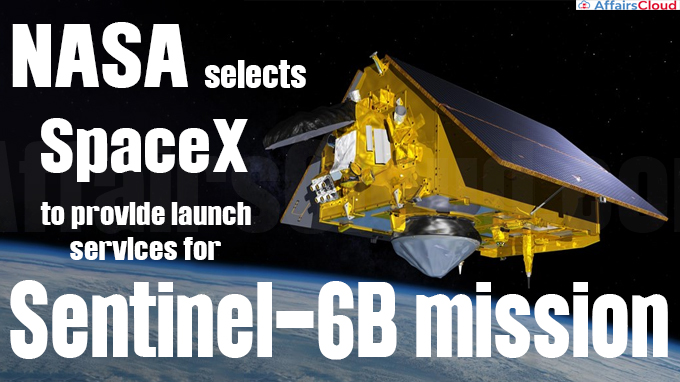 The National Aeronautics and Space Administration (NASA) of the United States (US) has granted Elon Musk’s Space Exploration Technologies (SpaceX) of Hawthorne, California, US, a contract for launch services for the ‘Sentinel-6B mission’ worth approximately USD 94 million.
The National Aeronautics and Space Administration (NASA) of the United States (US) has granted Elon Musk’s Space Exploration Technologies (SpaceX) of Hawthorne, California, US, a contract for launch services for the ‘Sentinel-6B mission’ worth approximately USD 94 million.
- The mission aims to continue global sea level observations for at least the next 10 years.
It is a collaboration among NASA, the National Oceanic and Atmospheric Administration (NOAA), the European Space Agency (ESA), and the European Organization for the Exploitation of Meteorological Satellites (EUMETSAT).
Backdrop
i.The US and Europe are collaborating on the Jason Continuity of Service (Jason-CS) mission aboard the Sentinel-6 spacecraft.
ii.Jason-CS/Sentinel-6 consists of two identical satellites:
- Sentinel-6 Michael Freilich, the first one launched on November 21, 2020
- Sentinel-6 B (Satellite B), the second one planned for launch in 2025
iii.In February 2020, ‘Sentinel-6 Michael Freilich’ (previously Satellite A) was renamed to honour Dr. Michael Freilich, former Director of NASA’s Earth Science Division (2006-19).
Sentinel-6B Mission
i.The Sentinel-6B mission will be launched in November 2025 on a SpaceX Falcon 9 rocket from Space Launch Complex 4E at Vandenberg Air Force Base in California.
- The ocean surveillance satellite Sentinel-6B will join its twin, Sentinel-6 Michael Freilich, which was launched on a Falcon 9 rocket.
ii.Sentinel-6B will continue Topex/Poseidon’s long-term global sea level data record, which began in 1992, and will be followed by Jason 1, 2, 3, and Sentinel-6 Michael Freilich.
iii.Sentinel-6B will offer continuous measurements of the ocean topography by bouncing signals off the ocean surface using a radar altimeter.
iv.As part of its effort to improve weather prediction models, the mission will also collect high-resolution vertical temperature profiles using the Global Navigation Satellite System Radio-Occultation (GNSS-RO) sounding technology.
Note: Program management for the SpaceX launch services is handled by NASA’s Launch Services Program at the Kennedy Space Center in Florida.
‘Project dearMoon’: Baalveer Actor Dev Joshi Among Eight-Member Crew for SpaceX Moon Trip
Dev Joshi, an India actor and influencer, is one of the 8 people who will fly to the moon in 2023 on a Starship spacecraft developed by Elon Musk’s SpaceX.
- This first civilian expedition to the moon is referred to as the “dearMoon Project.”
Dev Joshi is well known for his role as Baalveer in the television series “Baalveer.”
- Dev, the youngest crew member, was chosen alongside seven others from among one million candidates from 249 countries.
‘dearMoon Project’
i.The ‘dearMoon Project’ was announced in 2018, and crew selection began in 2021.
ii.Yusaku Maezawa, a Japanese entrepreneur, purchased all eight seats on SpaceX Starship spacecraft in 2018.
iii.The eight-member team consists of: K-pop singer T.O.P. (Choi Seung Hyun), American DJ Steve Aoki, American YouTuber Tim Dodd, Czech choreographer Yemi A.D., Irish photographer Rhiannon Adam, British photographer Karim Iliya, and the American filmmaker Brendan Hall headed by the Japanese tycoon Yusaku Maezawa.
iv.On this mission, the crew will head to the Moon aboard Starship and Super Heavy Rocket (formerly known as BFR), the next-generation reusable launch vehicle developed by SpaceX.
- It is a supersized rocket and spacecraft designed for transportation of people and cargo to the Moon, Mars and beyond.
v.They will spend six days travelling around the moon’s orbit on the Starship spacecraft before returning to Earth. It will not land on the moon.
Note: SpaceX has created a Starship spacecraft prototype for moon and Mars exploration, but has yet to achieve orbital spaceflight success.
About Yusaku Maezawa
i.Yusaku Maezawa established Zozotown, Japan’s largest online fashion mall, in 2004.
- He was ranked 18th richest in Japan by Forbes in 2021 with a personal wealth of USD 2.9 billion.
ii.Maezawa and his producer, Yozo Hirano, flew to the International Space Station (ISS) for 12 days in 2021 on a Russian Soyuz rocket.
iii.Maezawa was named the first private passenger to travel around the moon aboard SpaceX’s Starship rocket in 2018.
Recent Related News:
i.In November 2022, NASA launched its Space Launch System (SLS), the most powerful rocket in the world, and Orion spacecraft to the moon, as a part of the Artemis Program. The mission, dubbed Artemis I, marks the first flight of NASA’s SLS rocket and Orion spacecraft together.
ii.SLS carrying an uncrewed Orion lifted off its first test debut from the Launch Pad 39B at NASA’s Kennedy Space Center in Cape Canaveral, Florida, United States of America(USA). Orion is planned to travel approximately 40,000 miles beyond the Moon and return to Earth over the course of 25.5 days.
About the National Aeronautics and Space Administration (NASA):
Administrator – Bill Nelson
Headquarters – Washington D.C, United States




